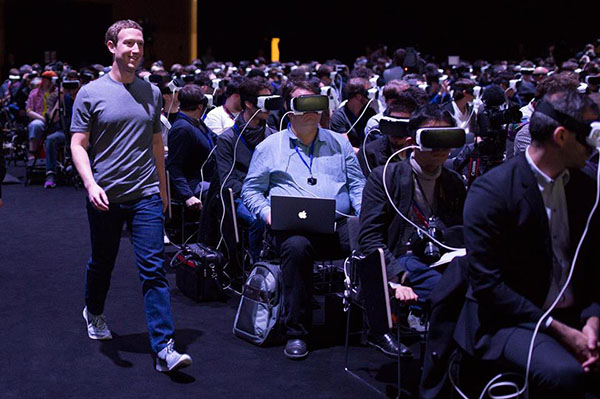Korean tech giant Samsung threw everything it could at this year’s Mobile World Congress (MWC), with a packed-out auditorium, a souped-up range of Galaxy phones, a guest appearance from Mark Zuckerberg, and virtual reality gear for the press to watch it all unfold.
But it was its country rival LG that turned heads on the eve of the event with announcement of a high-end smartphone with a degree of modularity.
Smartphone manufacturers have made Sunday the unofficial kick-off for MWC during recent years, and it has become an essential and increasingly noisy curtain raiser. This year, LG’s G5 was the best articulated of Sunday’s headliners, however much Samsung pumped up the volume.
We’ve had modular toys, furniture and buildings. Lately, we’ve also had modular smart watches. It’s a trend promising a higher degree or personalisation, and LG took the idea a step further on Sunday night. The G5 is the first attempt at a modular smartphone with a swappable component.
It lets you exchange the bottom bracket of the device for another accessory. LG has designed two for the purpose, its LG CAM Plus and LG Hi-Fi Plus, which turn it into a higher-end digital camera and a mini stereo system, respectively.
The phone’s battery, which hooks to the bracket, can be replaced with a spare. Otherwise, it’s a handsomely specified unit, with a gently curved screen, a 5.3-inch Quad HD IPS Quantum display, a Snapdragon 820 processor and various other hardware tricks.
But for its swappable bottom-end, its most notable innovation is to include two cameras on the rear: a 16-megapixel unit with a standard 78-degree lens and a second eight megapixel camera with a 135-degree wide angle lens, the widest of any smartphone. LG claims its viewing angle is 1.7 times wider than those of existing smartphone cameras.
For LG, the idea is presumably for third party brands to produce swappable gear for the G5. But its chief interest here, and the reason it took the headlines in the run-up, is as a pioneering design that will surely usher in a new wave of industrial design in the space.
Meanwhile, Samsung’s bells and whistles looked like sure things. Its new Galaxy S7 and S7 Edge take up where 2015’s S6 and S6 Edge left off. They will sell well at the high end, and have the Android crowd proclaiming the poverty of their peers on Apple iOS.
But they look remarkably similar to their forebears, and their internal pyrotechnics, whilst impressive, only make marginal gains. The S7 features a 64 bit octa-core (2.3GHz quad + 1.6GHz quad) processor and a 3,000mAh battery, which allows fast charging and wireless charging. Samsung has reinserted a microSD card, which went missing last time around.
The S7 Edge has the same screen as its predecessor, but advances it in terms of a larger 3,600mAh battery and a larger 5.5-inch screen. Both go on sale on March 11.
Arguably the biggest impact was an instantly viral photo posted by Mark Zuckerberg of his appearance at the Samsung event, walking down an aisle past hundreds of VR-wearing journalists.
There were handset announcements from the likes of Acer, Alcatel and OneTouch also, although these effectively sought to bring higher-end specifications down in price, rather than push any technological boundaries.
Much of the action and interest focused on accessories, and alternative technologies such as virtual reality and home connectivity.
Samsung’s most notable hardware announcement was perhaps its Gear 360 camera, equipped with dual fisheye lenses, both with 15 megapixel image sensors, giving users the ability to capture high-resolution (3840×1920) 360-degree video. It also supports 30 megapixel still images.
Available in Q2, it’s compatible with traditional computing platforms, but essentially designed for virtual reality headsets. By the end of the year, 360 degree ball cameras will be commonplace. LG also announced its own 360Cam at MWC, on its stand and as a footnote in its G5 accessories list.
Elsewhere at MWC, Sony claimed to have “reimagined” its Xperia range with the launch of two new devices, the X and XA, boasting curved screens, bumped-up battery life, and certain camera trickery to reduce blurring.
However, Sony’s most engaging announcement was for a wireless earpiece, the Xperia Ear. Like a limited and diminutive version of Amazon’s Echo, it fits in your ear, and reads out messages, calendar entries, and weather forecasts. It can also take verbal commands, so you can ask it to make a call, perform an internet search or dictate a message.
Meanwhile, Chinese manufacturer Huawei avoided devices altogether, having attempted to upset the Sunday night applecart with big hitting smartphone announcements of its own. It appeared to drop its well-tipped P9 smartphone from its schedule, and crossed over into an entirely new category by launching a single Windows 10-based tablet.
Thinner than Microsoft’s Surface Pro 4, its new MateBook features a 12-inch display and can be clipped into an add-on keyboard and used with a stylus.


